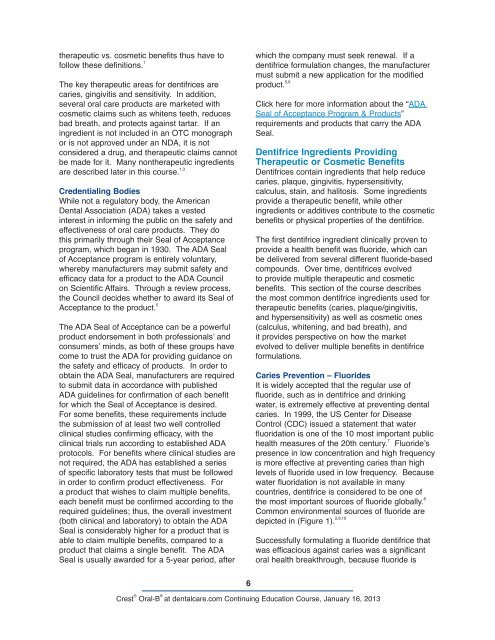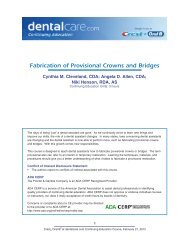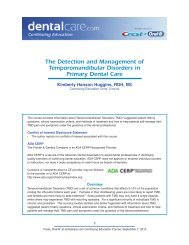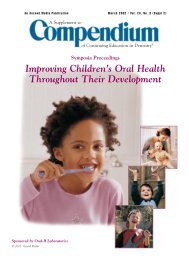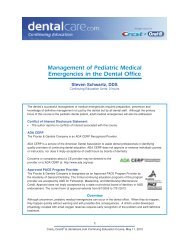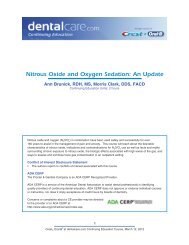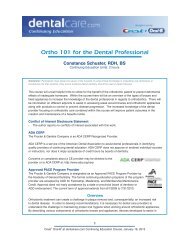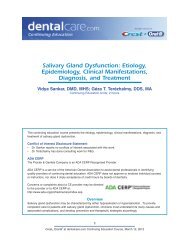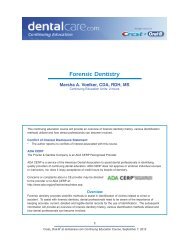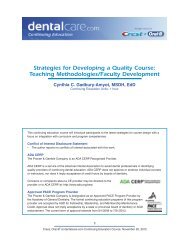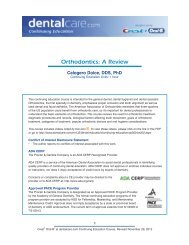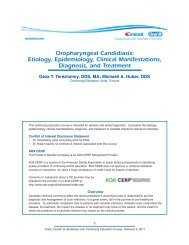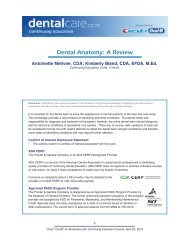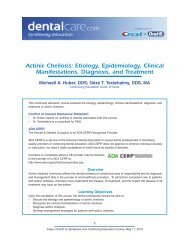CE410 - Fundamentals of Dentifrice: Oral Health ... - DentalCare.com
CE410 - Fundamentals of Dentifrice: Oral Health ... - DentalCare.com
CE410 - Fundamentals of Dentifrice: Oral Health ... - DentalCare.com
Create successful ePaper yourself
Turn your PDF publications into a flip-book with our unique Google optimized e-Paper software.
therapeutic vs. cosmetic benefits thus have to<br />
follow these definitions. 1<br />
The key therapeutic areas for dentifrices are<br />
caries, gingivitis and sensitivity. In addition,<br />
several oral care products are marketed with<br />
cosmetic claims such as whitens teeth, reduces<br />
bad breath, and protects against tartar. If an<br />
ingredient is not included in an OTC monograph<br />
or is not approved under an NDA, it is not<br />
considered a drug, and therapeutic claims cannot<br />
be made for it. Many nontherapeutic ingredients<br />
are described later in this course. 1,3<br />
Credentialing Bodies<br />
While not a regulatory body, the American<br />
Dental Association (ADA) takes a vested<br />
interest in informing the public on the safety and<br />
effectiveness <strong>of</strong> oral care products. They do<br />
this primarily through their Seal <strong>of</strong> Acceptance<br />
program, which began in 1930. The ADA Seal<br />
<strong>of</strong> Acceptance program is entirely voluntary,<br />
whereby manufacturers may submit safety and<br />
efficacy data for a product to the ADA Council<br />
on Scientific Affairs. Through a review process,<br />
the Council decides whether to award its Seal <strong>of</strong><br />
Acceptance to the product. 5<br />
The ADA Seal <strong>of</strong> Acceptance can be a powerful<br />
product endorsement in both pr<strong>of</strong>essionals’ and<br />
consumers’ minds, as both <strong>of</strong> these groups have<br />
<strong>com</strong>e to trust the ADA for providing guidance on<br />
the safety and efficacy <strong>of</strong> products. In order to<br />
obtain the ADA Seal, manufacturers are required<br />
to submit data in accordance with published<br />
ADA guidelines for confirmation <strong>of</strong> each benefit<br />
for which the Seal <strong>of</strong> Acceptance is desired.<br />
For some benefits, these requirements include<br />
the submission <strong>of</strong> at least two well controlled<br />
clinical studies confirming efficacy, with the<br />
clinical trials run according to established ADA<br />
protocols. For benefits where clinical studies are<br />
not required, the ADA has established a series<br />
<strong>of</strong> specific laboratory tests that must be followed<br />
in order to confirm product effectiveness. For<br />
a product that wishes to claim multiple benefits,<br />
each benefit must be confirmed according to the<br />
required guidelines; thus, the overall investment<br />
(both clinical and laboratory) to obtain the ADA<br />
Seal is considerably higher for a product that is<br />
able to claim multiple benefits, <strong>com</strong>pared to a<br />
product that claims a single benefit. The ADA<br />
Seal is usually awarded for a 5-year period, after<br />
6<br />
which the <strong>com</strong>pany must seek renewal. If a<br />
dentifrice formulation changes, the manufacturer<br />
must submit a new application for the modified<br />
product. 5,6<br />
Click here for more information about the “ADA<br />
Seal <strong>of</strong> Acceptance Program & Products”<br />
requirements and products that carry the ADA<br />
Seal.<br />
<strong>Dentifrice</strong> Ingredients Providing<br />
Therapeutic or Cosmetic Benefits<br />
<strong>Dentifrice</strong>s contain ingredients that help reduce<br />
caries, plaque, gingivitis, hypersensitivity,<br />
calculus, stain, and halitosis. Some ingredients<br />
provide a therapeutic benefit, while other<br />
ingredients or additives contribute to the cosmetic<br />
benefits or physical properties <strong>of</strong> the dentifrice.<br />
The first dentifrice ingredient clinically proven to<br />
provide a health benefit was fluoride, which can<br />
be delivered from several different fluoride-based<br />
<strong>com</strong>pounds. Over time, dentifrices evolved<br />
to provide multiple therapeutic and cosmetic<br />
benefits. This section <strong>of</strong> the course describes<br />
the most <strong>com</strong>mon dentifrice ingredients used for<br />
therapeutic benefits (caries, plaque/gingivitis,<br />
and hypersensitivity) as well as cosmetic ones<br />
(calculus, whitening, and bad breath), and<br />
it provides perspective on how the market<br />
evolved to deliver multiple benefits in dentifrice<br />
formulations.<br />
Caries Prevention – Fluorides<br />
It is widely accepted that the regular use <strong>of</strong><br />
fluoride, such as in dentifrice and drinking<br />
water, is extremely effective at preventing dental<br />
caries. In 1999, the US Center for Disease<br />
Control (CDC) issued a statement that water<br />
fluoridation is one <strong>of</strong> the 10 most important public<br />
health measures <strong>of</strong> the 20th century. 7 Fluoride’s<br />
presence in low concentration and high frequency<br />
is more effective at preventing caries than high<br />
levels <strong>of</strong> fluoride used in low frequency. Because<br />
water fluoridation is not available in many<br />
countries, dentifrice is considered to be one <strong>of</strong><br />
the most important sources <strong>of</strong> fluoride globally. 8<br />
Common environmental sources <strong>of</strong> fluoride are<br />
depicted in (Figure 1). 2,9,10<br />
Successfully formulating a fluoride dentifrice that<br />
was efficacious against caries was a significant<br />
oral health breakthrough, because fluoride is<br />
Crest ® <strong>Oral</strong>-B ®<br />
at dentalcare.<strong>com</strong> Continuing Education Course, January 16, 2013


